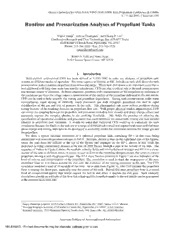
NASA Technical Reports Server (NTRS) 20070003730: Runtime and Pressurization Analyses of Propellant Tanks PDF
Preview NASA Technical Reports Server (NTRS) 20070003730: Runtime and Pressurization Analyses of Propellant Tanks
Abstract Submitted for 43rd AIAA/ASME/SAE/ASEE Joint Propulsion Conference & Exhibit 8 - 11 Jul 2007, Cincinnati, OH Runtime and Pressurization Analyses of Propellant Tanks Vineet Ahuja*, Ashvin Hosangadi†, and Chung P. Lee‡ Combustion Research and Flow Technology, Inc. (CRAFT Tech) 6210 Keller’s Church Road, Pipersville, PA 18947 Phone: 215-766-1520 / Fax: 215-766-1524 [email protected] Robert E Field and Harry Ryan NASA Stennis Space Center, MS 39529 I. Introduction Multi-element unstructured CFD has been utilized at NASA SSC to carry out analyses of propellant tank systems in different modes of operation. The three regimes of interest at SSC include (a) tank chill down (b) tank pressurization and (c) runtime propellant draw-down and purge. While tank chill down is an important event that is best addressed with long time-scale heat transfer calculations, CFD can play a critical role in the tank pressurization and runtime modes of operation. In these situations, problems with contamination of the propellant by inclusion of the pressurant gas from the ullage causes a deterioration of the quality of the propellant delivered to the test article. CFD can be used to help quantify the mixing and propellant degradation. During tank pressurization under some circumstances, rapid mixing of relatively warm pressurant gas with cryogenic propellant can lead to rapid densification of the gas and loss of pressure in the tank. This phenomenon can cause serious problems during testing because of the resulting decrease in propellant flow rate. With proper physical models implemented, CFD can model the coupling between the propellant and pressurant including heat transfer and phase change effects and accurately capture the complex physics in the evolving flowfields. This holds the promise of allowing the specification of operational conditions and procedures that could minimize the undesirable mixing and heat transfer inherent in propellant tank operation. It should be noted that traditional CFD modeling is inadequate for such simulations because the fluids in the tank are in a range of different sub-critical and supercritical states and elaborate phase change and mixing rules have to be developed to accurately model the interaction between the ullage gas and the propellant. We show a typical run-time simulation of a spherical propellant tank, containing RP-1 in this case, being pressurized with room-temperature nitrogen at 540 R. Nitrogen, shown in blue on the right-hand side of the figures, enters the tank from the diffuser at the top of the figures and impinges on the RP-1, shown in red, while the propellant is being continuously drained at the rate of 1050 lbs/sec through a pipe at the bottom of the tank. The sequence of frames in Figure 1 shows the resultant velocity fields and mixing between nitrogen and RP-1 in a cross- section of the tank at different times. A vortex is seen to form in the incoming nitrogen stream that tends to entrain propellant, mixing it with the pressurant gas. The RP-1 mass fraction contours in Figure 1 are also indicative of the level of mixing and contamination of the propellant. The simulation is used to track the propagation of the pure propellant front as it is drawn toward the exit with the evolution of the mixing processes in the tank. The CFD simulation modeled a total of 10 seconds of run time. As is seen from Figure 1d, after 5.65 seconds the propellant front is nearing the drain pipe, especially near the center of the tank. Behind this pure propellant front is a mixed fluid of compromised quality that would require the test to end when it reaches the exit pipe. Such unsteady simulations provide an estimate of the time that a high-quality propellant supply to the test article can be guaranteed at the modeled mass flow rate. * Senior Research Scientist, 6210 Keller’s Church Rd., Pipersville, PA 18947, Senior AIAA Member. † Principal Research Scientist, 6210 Keller’s Church Rd., Pipersville, PA 18947, AIAA Member. ‡ Research Scientist, 3313 Memorial Parkway South, Suite 108, Huntsville, AL, AIAA Member. 1 American Institute of Aeronautics and Astronautics RELEASED - Printed documents may be obsolete; validate prior to use. Abstract Submitted for 43rd AIAA/ASME/SAE/ASEE Joint Propulsion Conference & Exhibit 8 - 11 Jul 2007, Cincinnati, OH (a) (b) (c) (d) Figure 1. Runtime Simulation Of RP-1 Pressurized With Nitrogen. In the final paper, we will discuss simulations of the LOX and propellant tanks at NASA SSC being pressurized by an inert ullage. Detailed comparisons will be made between the CFD simulations and lower order models as well as with test data. Conditions leading to cryo collapse in the tank will also be identified. 2 American Institute of Aeronautics and Astronautics RELEASED - Printed documents may be obsolete; validate prior to use.
